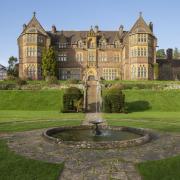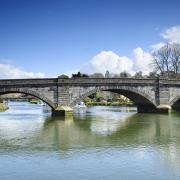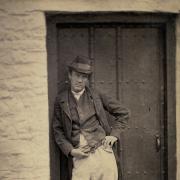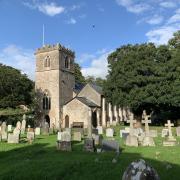Exeter's Lost Buildings by Todd Gray reveals the large scale destruction of the city's heritage in the 19th century
Exeter’s cathedral is a jewel in the crown, it is a beautiful and ancient building, one we look at in awe.
However, it’s hard to visualise what the area around the cathedral used to look like because, as the historian Dr Todd Gray reveals in his latest book, during the 19th century at least 50 historic buildings were demolished by the cathedral’s Dean & Chapter. This ‘improvement’ work, was about clearing the site, to enhance the views of the cathedral and enable it to stand out.
This amount of destruction was extraordinary and unique to Exeter in its extent, as Todd discovered during his research. He wrote to every diocese in the country to see if a similar approach had been taken in other cathedral cities. ‘Some had a little bit of this taking place, but nowhere as much as Exeter,’ he says.
It was not just the cathedral. During the 1800s Exeter saw hundreds of historic buildings, many distinctive 16th and 17th century merchants’ houses, demolished by the city’s improvement Commissioners and its Streets Committee.
Most people associate Exeter’s loss of historic buildings with the bombing and rebuilding work that followed the Second World War, but this earlier period which saw such dramatic changes has not previously been fully appreciated.

Todd’s book seeks to address this gap in knowledge and to also show how, in the wake of the destruction, there arose an awareness of the value of the historic buildings and the desire to preserve the city’s architectural heritage.
‘One thing that came out of this was the fury in Exeter in the late 1800s as they saw one treasured building after another going.’
The first public comments decrying the demolition came in around 1821, says Todd. ‘People at the time were pleading to save the buildings, pleading. One man describes it as “the lifeblood of Exeter, every building gone is like a drop of blood disappearing”. ‘
This outcry he says, was to give rise to what we know today as normal – the idea of protecting buildings. So, in this regard he sees Exeter’s Lost Buildings as an encouraging and positive story that led to collective action which went on to become backed up by legislation.
‘One of the messages in the book is that all those losses we had in the 1800s, they came at a time when society was starting to say, “Wait a minute, you don’t have the right as individuals to pull that down, that belongs to society, it is our heritage, it’s out culture.” In the 1800s nobody is saying that, but by 1900 it had become the common thing to say, that we need to protect buildings.’
There was a health element to the improvement work, making streets wider, encouraging more airflow and space, and buildings were also lost through fire during that century.

One chapter of the book looks at the loss due to fire, but it was not a huge factor in the changes to Exeter’s architecture. The city didn’t suffer the same major losses as experienced in other Devon towns, including Tiverton, Crediton and Chudleigh. Most of its major fire loss came during the Second World War; during the 19th century buildings were lost to fire in sporadic and individual outbreaks.
Todd’s book includes many illustrations of lost buildings and first-hand accounts of what was happening at the time. He uncovered ‘wonderful examples of where the building was demolished, but people saved a portion of it’.
One of these was King John Tavern which dated back to the 1500s and once stood at 100 South Street. It was known for its wooden carvings and had a tall open hall with a winding staircase and wooden galleries. It was mostly destroyed by the city’s commissioners in 1834, but whole portions of the building were salvaged by the owners and kept by the family until the 1970s when they were sold to an American museum.
‘Thousands of people in Manhattan have seen them on exhibition this year whereas in Exeter we lost all memory of it,’ says Todd.
Painting and sketches of the tavern were made by several artists at the time, and these have provided an important record.
Many illustrations appear in the book. There were two artists in particular who were recording historic buildings in Exeter during the 1800s.
George Townsend and John Gendall would draw the buildings before they were demolished, even rushing to the sites with paper and ink as the builders started to take them down.
It is ‘absolutely fascinating,’ says Todd. ‘They were recording in a way no one else did.
‘They did this, they say, for two reasons, their love of Exeter and their appreciation for the old buildings.
‘These are men in the 1800s who are far ahead fo their time. We have well over 100 drawings, images and sketches by them. On some we can see the workmen with their ladders against the buildings pulling them down and these artists are including them in their drawings.
‘If I wanted to do this book on Plymouth or Barnstaple or Totnes, anywhere else in Devon I coudn’t do it - because I don’t have the art.

‘Mr Townsend and Mr Gendall have come out of this as stars.’
Something also distinctive to Exeter is that from the 1800s onwards there were ‘really good curators, librarians and archivists who gathered this material, recorded it and preserved it. This didn’t happen anywhere else,’ says Todd.
‘They had no money, but these men are going out and actually asking for images.’
Todd’s admits that he now thinks of these people whenever he goes past one of Exeter’s historic buildings: ‘I see these men standing in front of them, the ghosts of them, they’re protectors.’
In his conclusion to the book, Todd says: ‘Of the 1,500 or so buildings that existed in 1800 only a portion survived fire, redevelopment and improvement and were still standing in 1900.’
He hopes Exeter’s Lost Buildings will be ‘an awakening’.
‘Every generation has threats’, he says. Today there is a move to narrow streets, have less traffic and to build housing for town centre residents.
‘You can get complacent with thinking what you have will always be there.
‘We are living in a time where councils are desperate for space to put up more houses. But if we are going to have a thriving high street, we need old buildings for atmosphere.
'I’m trying to bring out the history that people don’t know about and apply it to today, so that we can be better informed to make decisions.’
Exeter’s historic buildings he says, ‘are our big hope, so we should cherish them.’
All the images are taken from Exeter's Lost Buildings: Destruction from 1800 to 1899 by Todd Gray, £22, The Mint Press stevensbooks.co.uk



























